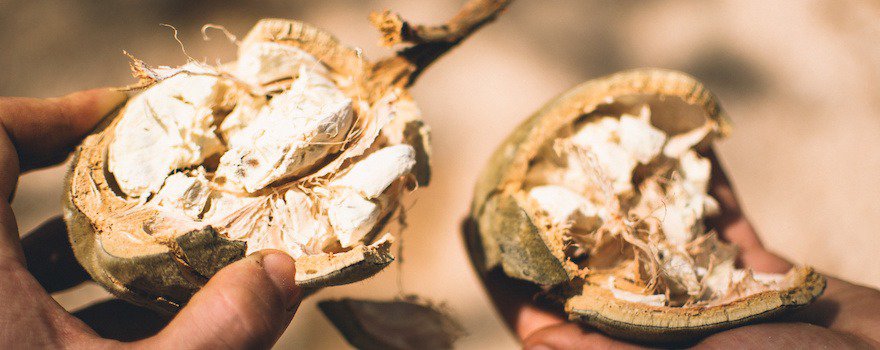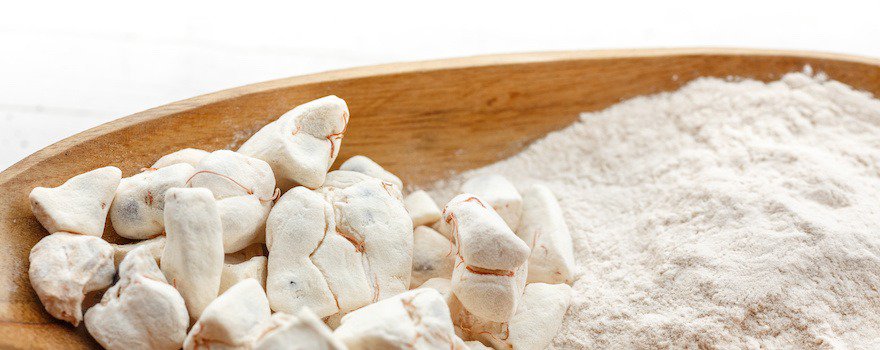BENEFITS OF BAOBAB
✓ Tones the body
✓ Relieves pain
✓ Supports the joints
✓ Fights free radicals
✓ Improves intestinal transit
What is the baobab?
The botanical genus Adansonia includes around ten species of baobab native to Africa, Madagascar or Australia. But, in herbal medicine, the term baobab refers more specifically to the best-known variety: the African baobab or Adansonia digitata. The latter belongs to the Bombacaceae family, which includes many remarkable tree species.
The baobab inspires respect. Able to reach 25 m in height and more than 20 m in circumference, its lifespan is exceptional: from 1000 to 2000 years. As such, some baobabs are classified among the oldest trees in the world.
From June until the end of August, the baobab is adorned with large white, hanging flowers that bloom at dusk and last only one night. Their scent and nectar attract animals that will pollinate the flowers. This is notably the case for the Egyptian rousette and African straw-colored rousette.

The baobab produces large oval fruits, called “monkey bread”, with a tough, woolly rind. Each of them contains numerous edible seeds but is primarily composed of nearly 30% pulp. The pulp of the baobab fruit is eaten by many animals (elephants, monkeys, rodents…) that find an excellent source of nutrients in it.
People have also recognized the pulp’s health benefits. Baobab fruit is an integral part of African culture and traditional medicine.
In Senegal, the pulp is notably used to make bouye juice, a refreshing drink that improves intestinal transit and relieves diarrhea. It is particularly rich in antioxidants.
The pulp can also be added to bread dough, once separated from the seeds and ground into powder. Other parts of the baobab are consumed by local populations, such as the bark or the leaves, which are rich in vitamins C and A, iron and mucilage.
In the West, research on the baobab fruit has helped to reveal a bit more about its remarkable nutritional composition. As shown by this study from Ghent University (Belgium) and the Czech University of Life Sciences in Prague (Czech Republic), the pulp contains a significant amount of vitamin C, fiber, proteins, lipids, minerals and trace elements (calcium, phosphorus, potassium…).
Nutritional composition
- 18 acides aminés dont 8 essentiels : proline, histidine, thréonine, tryptophane, phénylalanine, valine, méthionine, leucine, lysine, tyrosine…
- Vitamines : A, B1, B2, B3, C
- Minéraux et oligo-éléments : calcium, cuivre, fer, potassium, magnésium, manganèse, sodium, phosphore, zinc
- Acides gras : acide oléique, acide linoléique, acide palmitique, acide stéarique…
- Caroténoïde : lutéine
- Acides naturels : acide citrique, acide tartrique, acide malique, acide succinique
- Actifs antioxydants : procyanidines, flavonoïdes
- Protéines
- Glucides
- Fibres
- Sucres : fructose, saccharose, glucose
- Pectines

Benefits
⚡️ Strengthens the body
The pulp of the baobab fruit has a high vitamin C content (or ascorbic acid) with 373 mg per 100 g. Thus, it contains 7 times more vitamin C than lemon (50 mg per 100 g) and 6 times more than orange (57 mg per 100 g). Ascorbic acid is the quintessential vitamin for energy and vitality. It notably strengthens the immune system, improves iron absorption and fights free radicals.
Other components of the pulp also have a tonifying effect. This is the case for carbohydrates and lipids, which are the main sources of energy for our body, and vitamin B2 (riboflavin), which contributes to energy metabolism.
Thanks to these different components, baobab fruit pulp is ideal for people who are tired, convalescing, or to help prevent winter illnesses (colds, flu…) by strengthening the immune system.
This study from the University of Abomey-Calavi (Benin), conducted in a laboratory, shows the high vitamin C content of baobab fruit pulp.
💆♂️ Relieves pain
Baobab is also known for its analgesic action — that is, its ability to reduce pain. This property is found in the pulp as well as in the tree’s bark, consumed as an infusion or decoction.
Baobab is particularly effective for relieving muscle and joint pain, especially since it also helps reduce inflammation. In this sense, its properties are similar to those of another tree, boswellia.
B vitamins, vitamin C, phenylalanine and histidine are responsible for this pain-relieving action. Phenylalanine, for example, is an essential amino acid involved in reducing pain, including chronic pain. To do this, it inhibits the activity of enkephalinase, a brain enzyme that amplifies pain signals.
This study from the University of Ilorin (Nigeria), conducted on rats, demonstrates the analgesic effect of the bark extract of the African baobab.
🤸🏼♀️ Supports the joints
Numerous studies have highlighted the benefits of baobab for the joints. Both the leaves and the pulp are valuable allies in cases of inflammatory diseases such as osteoarthritis or rheumatoid arthritis. Indeed, in addition to relieving joint pain, baobab reduces inflammation, much like turmeric.
This action is largely due to the presence of methionine, proline, polyphenols and vitamins that help to reduce cytokines, substances that promote inflammation. Vitamin A (or retinol) acts notably on the inflammatory mediator MCP-1 (monocyte chemoattractant protein 1), involved in several diseases such as rheumatoid arthritis.
Also read the These natural and tasty anti-inflammatory foods
B vitamins also play an important role in reducing inflammation in the joints. As for methionine and proline, they are amino acids that contribute to the formation of cartilage.
This study from Addis Ababa University in Ethiopia and Soonchunhyang University in South Korea, conducted on cells, shows how African baobab leaf extract exerts its anti-inflammatory effects.
🥝 Fights free radicals
Baobab pulp is particularly rich in antioxidant compounds : vitamin A, vitamin C, procyanidins, flavonoids, carotenoids… So many compounds that fight free radicals and prevent damage to cells.
The procyanidins contained in baobab fruit pulp are tannins present in some fruits, such as grapes or apples, and in the cocoa. They are known for their ability to scavenge free radicals and for their effectiveness in preventing oxidative stress.
In this study from the University of Pisa in Italy, carried out on samples of dried fruit pulp, the researchers examined the antioxidant activity of baobab.
This other study from the University of Leeds in the United Kingdom, also conducted on pulp, highlighted the bioactive components and their antioxidant activity.
♻️ Improves intestinal transit
Consuming baobab fruit pulp is useful for improving intestinal transit and relieving gastrointestinal disorders. Rich in fiber and mucilage, it has an antidiarrheal action that reduces the symptoms of diarrhea and dysentery. At the same time, it helps rehydrate the body to compensate for water loss.
The soluble fibers contained in the pulp also act as prebiotics : they encourage the development of beneficial bacteria (Lactobacillus plantarum, Streptococcus lactis…) in the intestinal microbiota.
Finally, histidine is an amino acid with antispasmodic properties that helps relieve intestinal cramps and colic.
This study from the University of Agriculture, Abeokuta in Nigeria, conducted on bacteria, shows how baobab pulp led to an increase in lactic bacteria populations.

How to consume baobab?
In tablet form
Baobab tablets or capsules contain baobab fruit pulp ground into powder. This form is easier to take than the powder and has the advantage of being tasteless. It is suitable for taking as a course for a few weeks.
Preferably choose capsules that are 100% natural and/or certified organic, non-GMO, and free of colorings and preservatives.
In powder form

Baobab powder is easily found in organic and specialty stores or online. After harvest, the shells are opened to extract the pulp. It is then separated from the seeds, dried, ground into powder, and sieved.
Baobab powder has a slightly tangy taste that pairs very well with sweet preparations : cereals, pancakes, yogurts, cake batter… You can also sprinkle it on salads or simply mix it with water, a fruit juice or a smoothie.
As juice
Baobab juices are available commercially, and they are increasingly common. You can find just about anything, with manufacturers riding the trend for this super fruit! Always check the amount of baobab and sugar so you don’t end up with a juice high in glucose and nutritionally poor. Choose them, whenever possible, without colorants, preservatives, or artificial flavors.
Why choose organic and fair-trade baobab?
When choosing your dietary supplement or juice, check the origin of the baobab. Prefer sources in Senegal, Mali and Benin, where the harvests are still artisanal.
Baobab can also come from a fair and responsible supply chain (label « Fair for Life ») that provides economic support to local communities.
Baobab and spirulina
The baobab/spirulina combination is ideal for strengthening the immune system, and for staying fit or getting back in shape. Thanks to its content of trace elements and gamma-linolenic acid, spirulina (Arthrospira platensis) contributes to the proper functioning of the immune system. Both baobab and spirulina contain antioxidant pigments (phycocyanins) that fight free radicals.
Dosage
⚖️ It is recommended not to consume more than 15 g per day of baobab powder.
⏳ Intake should preferably be in the morning and at midday, before meals. Because of its stimulating effect, avoid consuming baobab late in the day to prevent insomnia.
⏳ Baobab can be taken daily for maintenance, or as a course lasting from 20 days to 2 months. Undergoing a course can help restore fitness in people recovering from illness or after each change of season.
💊 Tablets: up to 6 per day for 355 mg capsules.
🥄 Powder form : up to 15 g per day.
Contraindications and side effects
Some compounds present in baobab fruit pulp make it contraindicated and not recommended for the following people :
- Par mesure de précaution, les jeunes enfants, les femmes enceintes ou allaitantes doivent éviter de prendre du baobab.
- En raison de sa teneur en potassium, le baobab est déconseillé aux personnes souffrant d’insuffisance cardiaque ou rénale.
- Les personnes concernées par des troubles intestinaux doivent consommer du baobab avec précaution. Sa forte teneur en fibres peut être source de ballonnements et de flatulences.
Baobab intake may cause the following side effects :
- Effet laxatif.
- Inconfort digestif, ballonnements et flatulences.
If symptoms persist, stop taking it and consult a doctor.
History, cultivation and market
A tree rooted in African culture

Native to the Sub-Saharan savanna, the African baobab grows mainly in the Sahel region : Senegal, Mali, Burkina Faso, Nigeria… But it is found throughout Africa, including on the islands: Madagascar, Comoros…
The baobab, the famous ‘palaver tree’, remains deeply rooted in African culture. Local populations use it for therapeutic, nutritional, economic and sociocultural purposes. In Senegal, all parts of the tree have a use: its leaves are used in cooking, the bark is used to make rope and the juice extracted from the fruit relieves diarrhea.
Gradually, the baobab has also become an important source of income for local people. In 2017, Africa exported 450 tonnes of powder of pulp (versus 50 tonnes in 2013). And international demand continues to grow. The baobab market could represent 350 million euros by 2025 according to the African Baobab Alliance.
A threatened tree
Unfortunately, baobabs are in danger. Currently, 6 of the 8 baobab species represented worldwide are threatened and listed on the IUCN Red List (International Union for Conservation of Nature). Climate change, intensive production, and industrial development in Africa are the main threats facing baobabs.
Despite its exceptional drought resistance, the baobab is weakened by rising temperatures. In Senegal, the cement industry and the establishment of quarries further weaken the African baobab.
Report by Julia Perez and Charlotte Jean
Sources and scientific studies
Emmy De Caluwé, Kateřina Halamová, Patrick Van Damme, 2010. Adansonia digitata L. – A review of traditional uses, phytochemistry and pharmacology.
Chadare FJ, Linnemann AR, Hounhouigan JD, Nout MJ, Van Boekel MA, 2009. Baobab food products: a review on their composition and nutritional value.
Bamidele Owoyele, Ahmed O Bakare, 2017. Analgesic properties of aqueous bark extract of Adansonia digitata in Wistar rats.
Yihunie Ayele, Jung-Ah Kim, Eunhee Park, Ye-Jung Kim, Negussie Retta, Gulelat Dessie, Sang-Ki Rhee, Kwangoh Koh, Kung-Woo Nam, and Hee Seon Kim, 2013. A Methanol Extract of Adansonia digitata L. Leaves Inhibits Pro-Inflammatory iNOS Possibly via the Inhibition of NF-κB Activation.
Alessandra Braca, Chiara Sinisgalli, Marinella De Leo, Beatrice Muscatello, Pier Luigi Cioni, Luigi Milella, Angela Ostuni, Sergio Giani, and Rokia Sanogo, 2018. Phytochemical Profile, Antioxidant and Antidiabetic Activities of Adansonia digitata L. (Baobab) from Mali, as a Source of Health-Promoting Compounds.
David T. Tembo, Melvin J. Holmes, Lisa J. Marshall, 2017. Effect of thermal treatment and storage on bioactive compounds, organic acids and antioxidant activity of baobab fruit (Adansonia digitata) pulp from Malawi.
Oluwatoyin Rebecca Afolabi, Tope Popoola, 2005. The effects of baobab pulp powder on the micro flora involved in tempe fermentation



